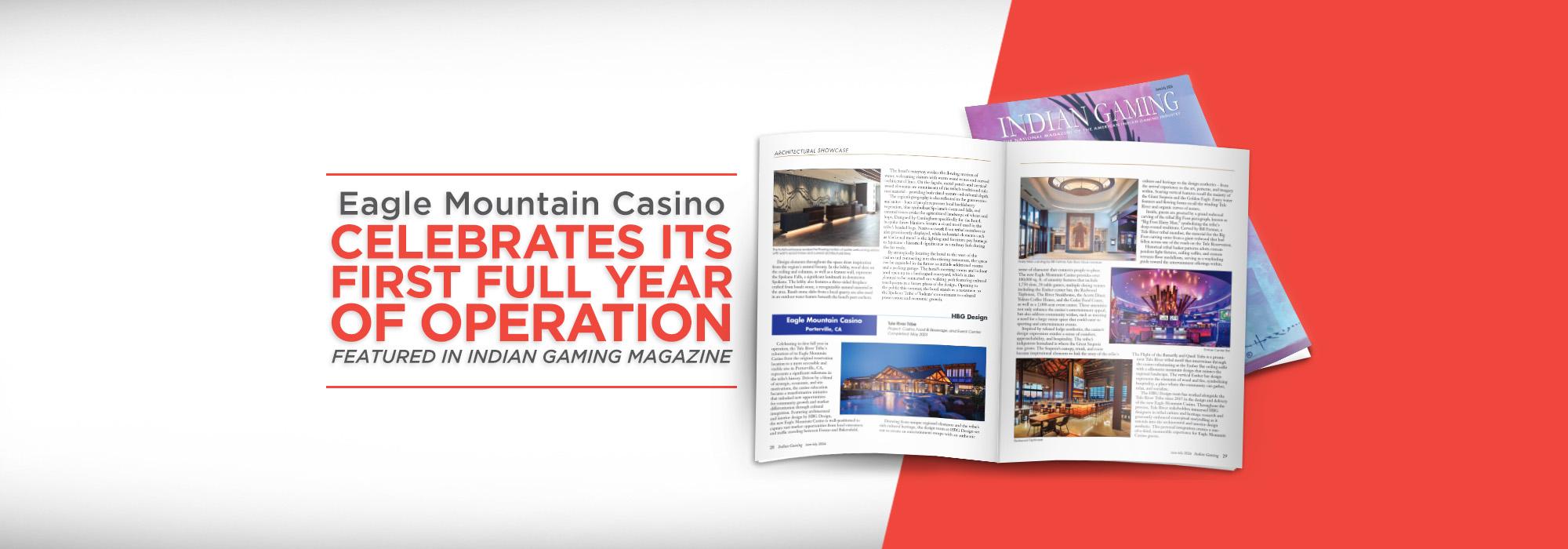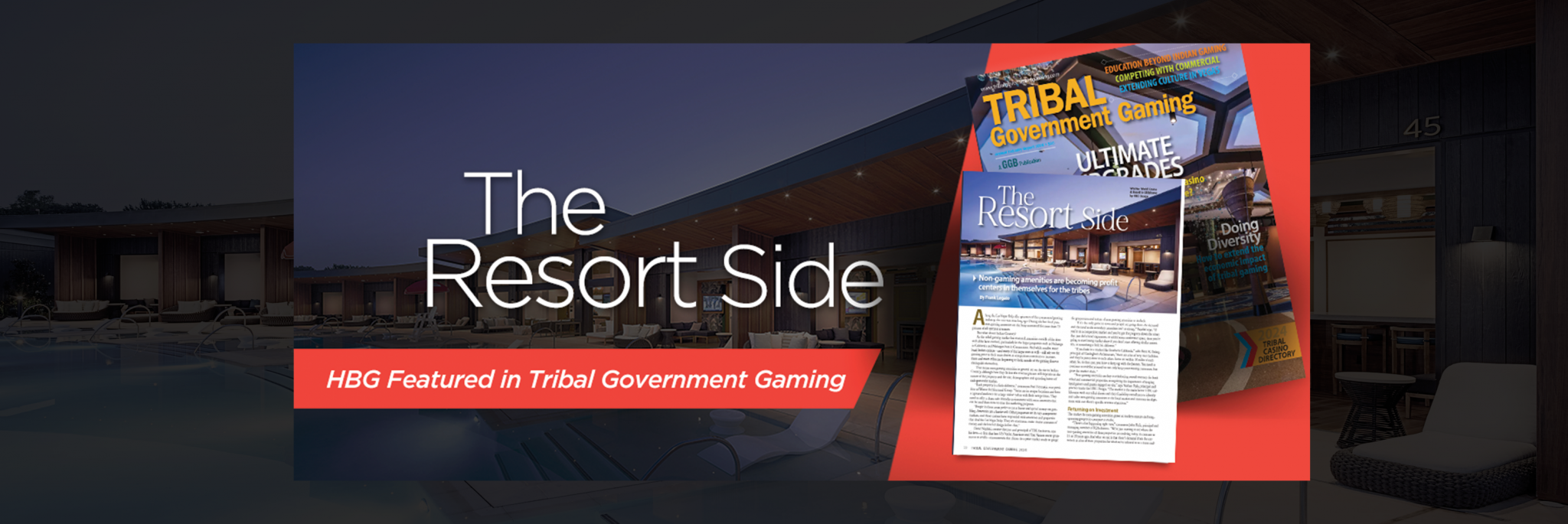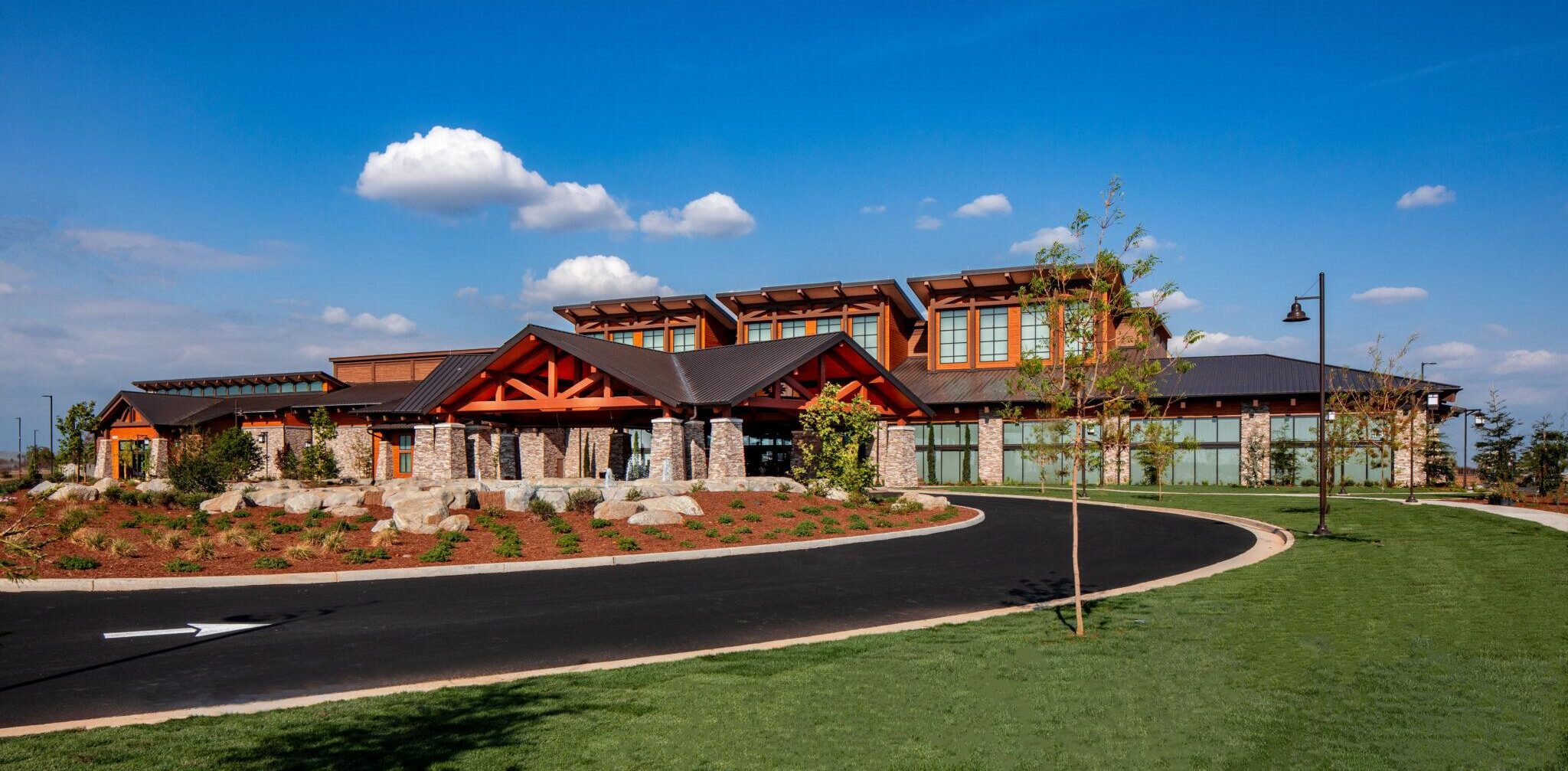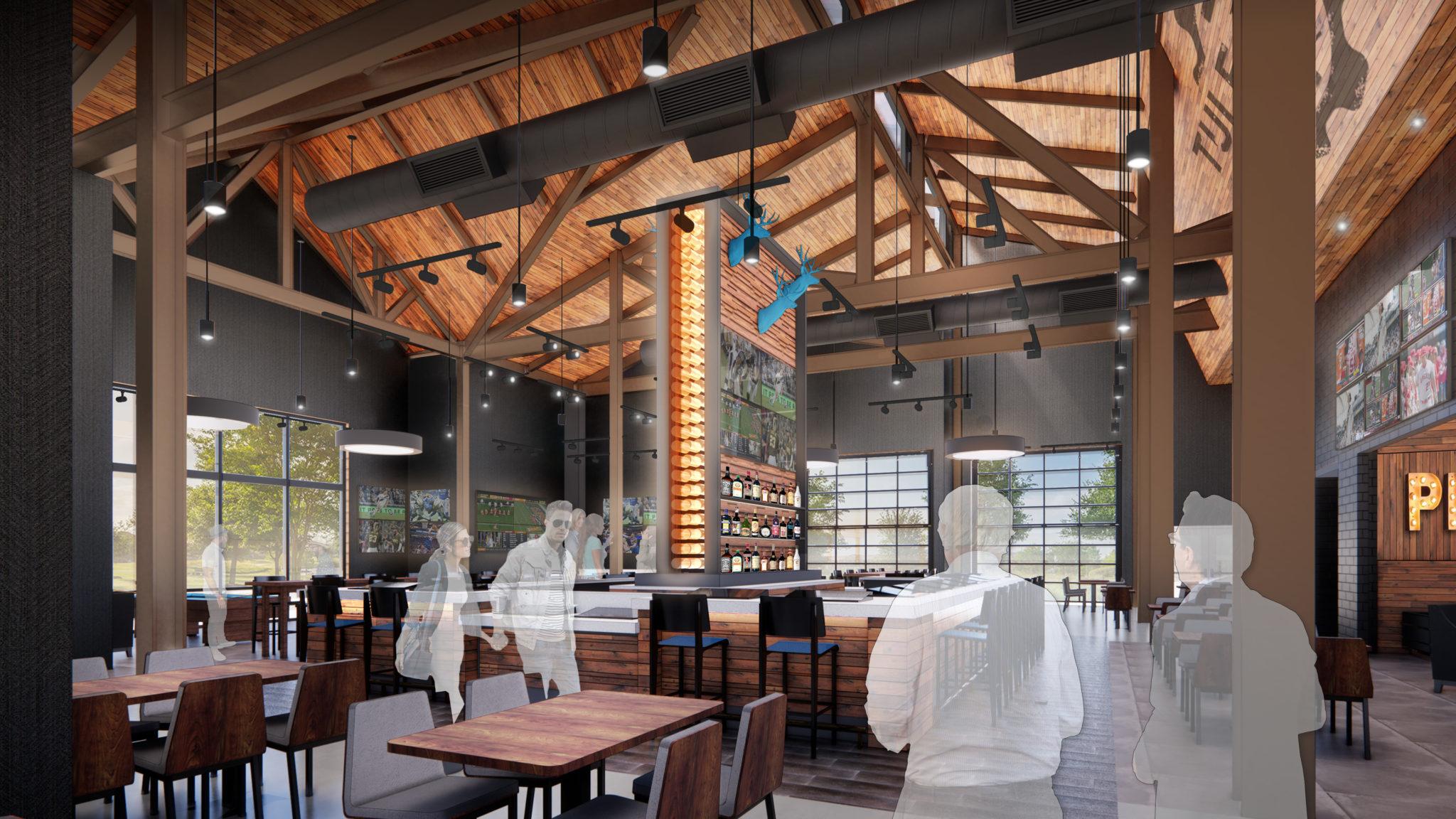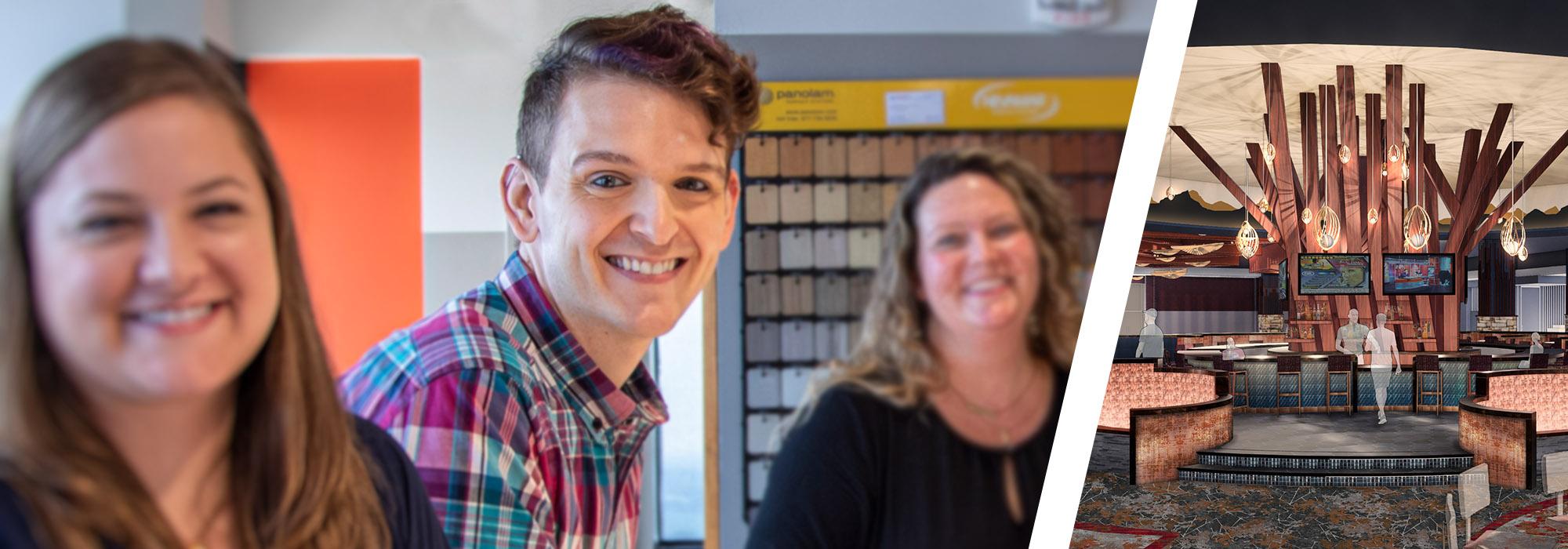Eagle Mountain's Successful Year One: Featured in Indian Gaming
Celebrating Eagle Mountain's Successful Year
Click Here to Read the Feature Article in Indian Gaming Magazine's June/July Design/Build Issue
Celebrating its first full year in operation, the Tule River Tribe's relocation of its Eagle Mountain Casino from the original reservation location to a more accessible and visible site in Porterville, California, represents a significant milestone in the tribe’s history. Driven by a blend of strategic, economic, and site motivations, the casino relocation became a transformative initiative that unlocked new opportunities for community growth and market differentiation through cultural integration. Featuring architectural and interior design by HBG Design, the new Eagle Mountain Casino is well-positioned to capture vast market opportunities from local customers and traffic traveling among the region’s major cities.
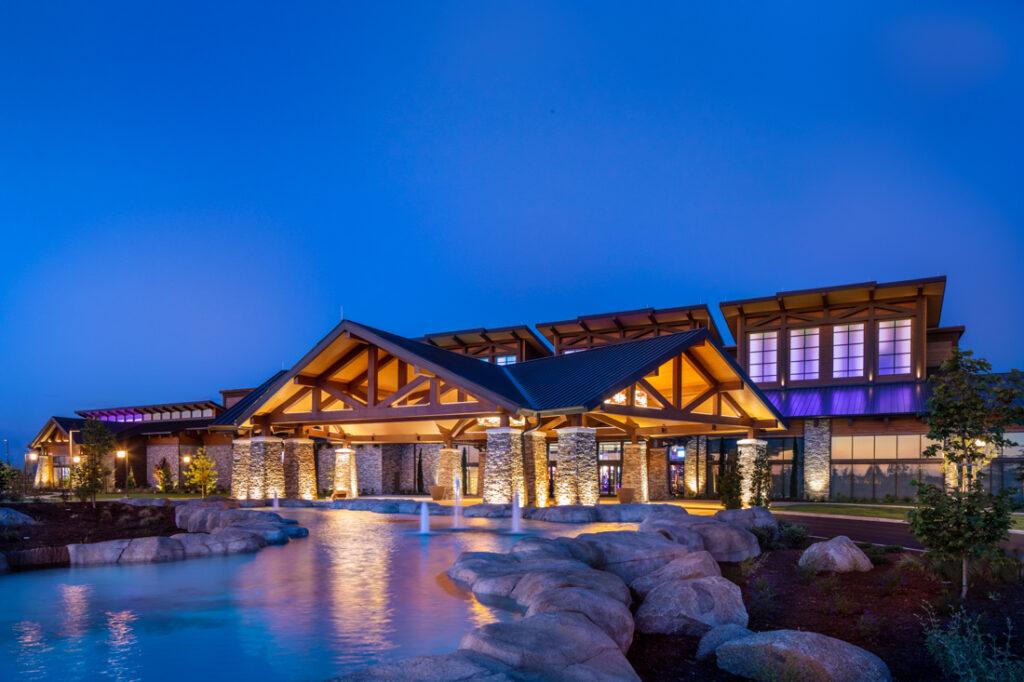
Drawing from unique regional elements and the tribe’s rich cultural heritage, the design team at HBG Design set out to create an entertainment escape with an authentic sense of character that connects people to place. The new Eagle Mountain Casino provides over 100,000 square feet of amenity features that include 1,750 slots, 20 table games, multiple dining venues including the Ember center bar, the Redwood Taphouse, The River Steakhouse, the Acorn Diner, Yokuts Coffee House, and the Cedar Food Court, as well as a 2,000-seat event center. These amenities not only enhance the casino's entertainment appeal, but also address community wishes, such as meeting a need for a large venue space that could cater to sporting and entertainment events.

Inspired by relaxed lodge aesthetics, the casino’s design expression exudes a sense of comfort, approachability, and hospitality. The tribe’s indigenous homeland is where the Great Sequoia tree grows. The Sequoia’s canopy, trunk, and roots became inspirational elements to link the story of the tribe's culture and heritage to the design aesthetics, from the arrival experience to the art, patterns, and imagery within. Soaring vertical features recall the majesty of the Giant Sequoia and the Golden Eagle. Entry water features and flowing forms recall the winding Tule River and organic curves of nature.
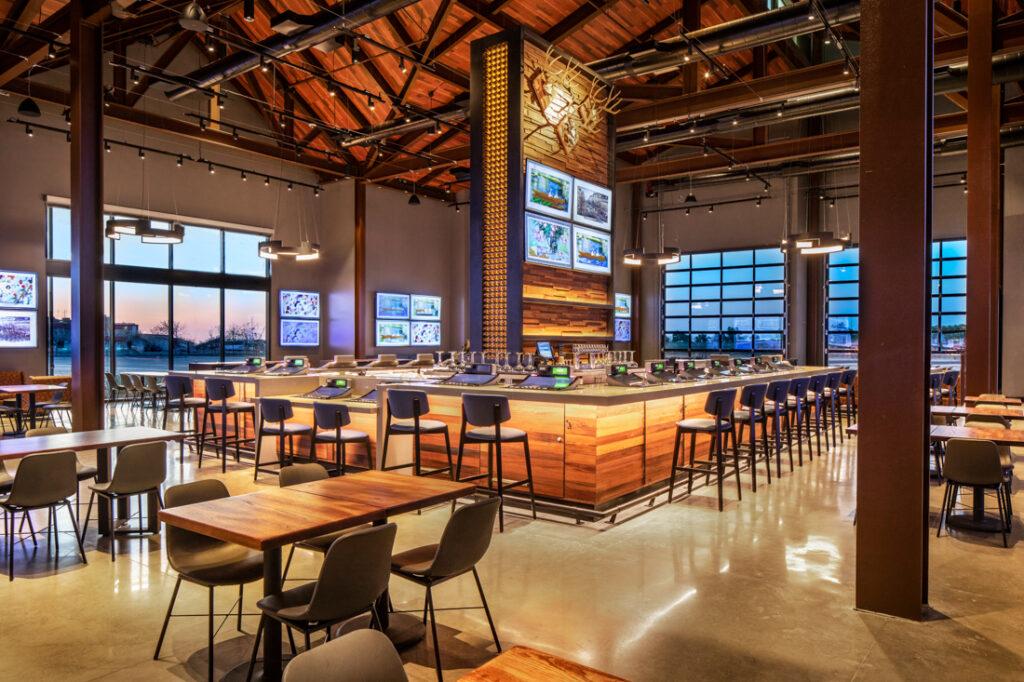
Inside, guests are greeted by a grand redwood carving of the tribal Big Foot pictograph, known as “Big Foot Hairy Man”, symbolizing the tribe's deep-rooted traditions. Carved by Bill Farmer, a Tule River Tribal Member, the material for the Big Foot carving came from a giant Redwood that had fallen across one of the roads on the Tule Reservation.
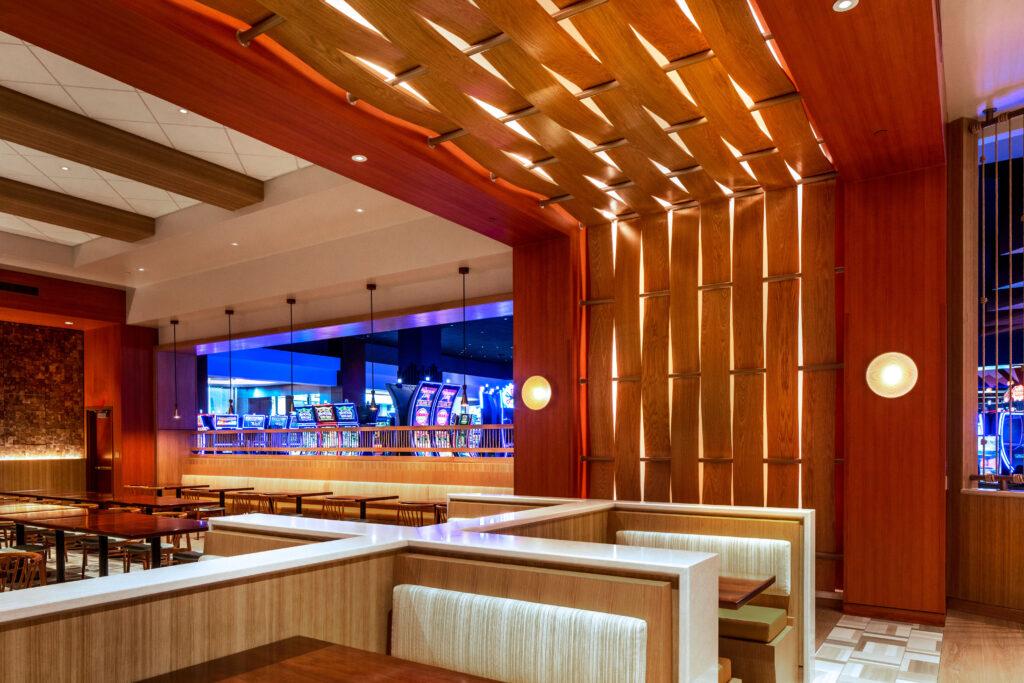
Historical tribal basket patterns adorn custom pendent light fixtures, ceilings soffits, and custom terrazzo floor medallions, serving as a wayfinding guide toward the entertainment offerings within.
The Flight of the Butterfly and Quail Tufts is a prominent Tule River tribal motif that intertwines through the casino culminating at the Ember Bar ceiling soffit with a silhouette mountain design that mimics the regional landscape. The vertical Ember bar design represents the elements of wood and fire, symbolizing hospitality, a place where the community can gather, relax, and socialize.
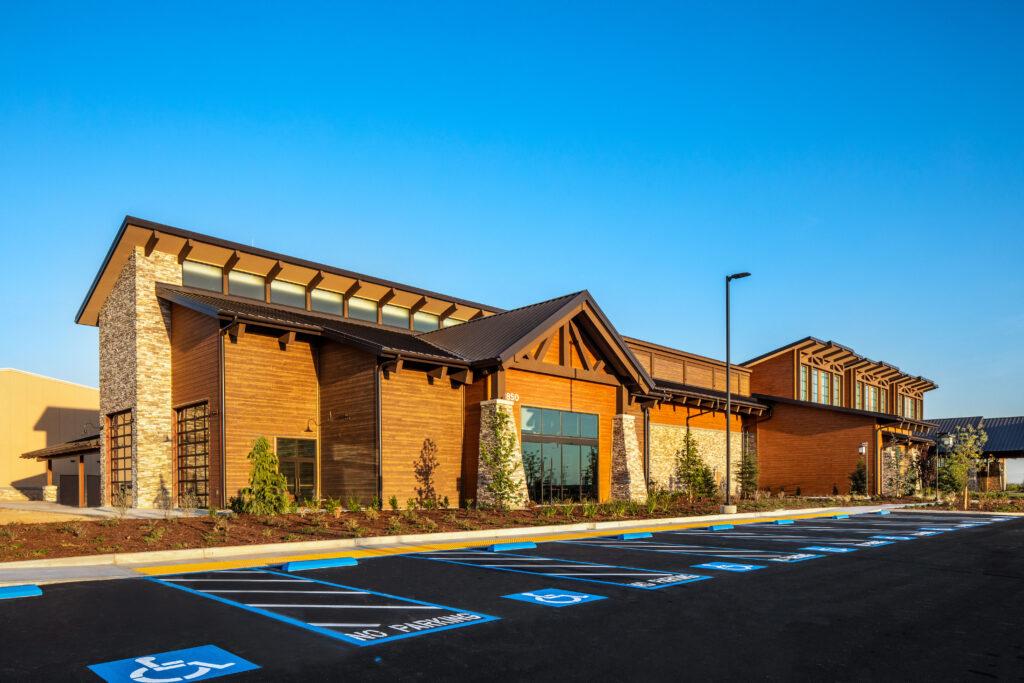
The HBG Design team is honored to have worked alongside the Tule River Tribe since 2015 in the design and delivery of the new Eagle Mountain Casino. Throughout the process, Tule River stakeholders immersed HBG designers in tribal culture and heritage research and graciously embraced conceptual storytelling as it extends into the architectural and interior design aesthetic. This personal integration creates a one-of-a-kind, memorable experience for Eagle Mountain Casino guests. #Eagle Mountain's Successful Year One
Embracing the Resort Side: A Look at HBG Design's Contributions to Non-Gaming Amenities in Tribal Casinos
In the evolving landscape of tribal gaming, non-gaming amenities have emerged as significant profit centers, enhancing the overall guest experience and driving new revenue streams. As the industry shifts towards providing comprehensive entertainment experiences, HBG Design stands at the forefront, partnering with tribal clients to innovate and tailor non-gaming amenities to meet local market demands.
WinStar World Casino & Resort: Setting New Standards
 One of the most notable projects by HBG Design is the WinStar World Casino & Resort in Oklahoma. Nathan Peak, Principal and Practice Leader for HBG Design, underscores the critical role of non-gaming amenities in reinforcing overall revenues. At WinStar, HBG Design has introduced several key non-gaming elements, including the Lucas Oil Live facility. This 6,500-seat venue, offering optimal acoustics and aesthetics, caters to the Dallas/Fort Worth market and hosts top-tier performers like Miranda Lambert and Rod Stewart. This project sets a new standard for live entertainment in the region, enhancing the guest experience with VIP event lounge suites and a dynamic LED-lit concourse.
One of the most notable projects by HBG Design is the WinStar World Casino & Resort in Oklahoma. Nathan Peak, Principal and Practice Leader for HBG Design, underscores the critical role of non-gaming amenities in reinforcing overall revenues. At WinStar, HBG Design has introduced several key non-gaming elements, including the Lucas Oil Live facility. This 6,500-seat venue, offering optimal acoustics and aesthetics, caters to the Dallas/Fort Worth market and hosts top-tier performers like Miranda Lambert and Rod Stewart. This project sets a new standard for live entertainment in the region, enhancing the guest experience with VIP event lounge suites and a dynamic LED-lit concourse.
Adjacent to Lucas Oil Live is the Session House Gastropub, seamlessly connecting the entertainment venue to the new 16-story, 304-key contemporary Spa Tower hotel. This integration exemplifies how HBG Design leverages non-gaming amenities to create holistic entertainment environments that attract a diverse array of guests.
Eagle Mountain Casino: Cultural Sensitivity and Unique Design

HBG Design’s commitment to integrating tribal culture and heritage into their projects is evident in the new 105,000-square-foot Eagle Mountain Casino operated by the Tule River Tribe in Porterville, California. Nathan Peak highlights how the design reflects the tribe's cultural symbols, with soaring vertical features recalling the giant sequoia and golden eagle, and flowing forms inspired by the Tule River. This thoughtful incorporation of cultural elements creates a distinctive and immersive environment for guests, setting the casino apart in the competitive market.
Expanding Horizons at Gun Lake Casino
 At the Gun Lake Casino in Michigan, HBG Design is pushing the envelope with the Wawye Oasis, a multi-purpose pool and event center atrium complex. This innovative space will offer a climate-controlled indoor environment shaped like a large sun dial, maintaining a cozy 82-degree climate year-round. The versatility of this space, transitioning from a resort pool oasis by day to a dynamic performance complex by night, exemplifies HBG Design’s ability to create multifunctional amenities that maximize return on investment.
At the Gun Lake Casino in Michigan, HBG Design is pushing the envelope with the Wawye Oasis, a multi-purpose pool and event center atrium complex. This innovative space will offer a climate-controlled indoor environment shaped like a large sun dial, maintaining a cozy 82-degree climate year-round. The versatility of this space, transitioning from a resort pool oasis by day to a dynamic performance complex by night, exemplifies HBG Design’s ability to create multifunctional amenities that maximize return on investment.
Enhancing Convenience with Parking Solutions
Parking facilities are often overlooked but critical components of non-gaming amenities. Nathan Peak emphasizes the importance of parking structures for guest convenience, particularly in regions with adverse weather conditions. HBG Design’s strategic planning ensures that these facilities not only protect guests but also provide quick and easy access to the gaming floor, thereby enhancing the overall guest experience and contributing to the property's profitability.
Conclusion: Innovating for the Future
HBG Design continues to lead the way in integrating non-gaming amenities into tribal casinos, recognizing their crucial role in attracting diverse guests and extending their stay. By blending cultural sensitivity with innovative design and strategic planning, HBG Design helps tribal casinos create unique, immersive experiences that drive revenue and set new industry standards. As the market for non-gaming amenities grows, HBG Design remains dedicated to partnering with tribal clients to deliver tailored solutions that meet their specific revenue objectives and enrich the guest experience.
See full article in Tribal Government Gaming
Unveiling the Cultural Richness of the new Eagle Mountain Casino
AN ENTERTAINMENT ESCAPE:
The new Eagle Mountain Casino connects People to Place.
HBG Design, the architecture and interior design firm behind Eagle Mountain Casino’s new development in Porterville, California, has unveiled a project that offers a fresh interpretation of the culture and heritage of the Tule River Tribe.
Welcome to Eagle Mountain Casino, where Tule River Tribe's culture and heritage are beautifully integrated.
HBG's design concept pays tribute to the tribe, capturing their customs and traditions throughout the casino. Inspired by the scenic Tulare County and Central California, the design reflects a meticulous crafting of boldness, captivating details, and engaging elements.
A variety of tribal basket patterning and motifs highlight ceiling and floor planes and light fixtures, drawing guests through wayfinding paths, to the 1750 machine casino, the Ember Center Bar, The River Steakhouse, The Acorn Diner, The Cedar Food Court, Yokuts Coffee House, and the Redwood Taphouse, and a new 2,000-seat event center. HBG designers merged concepts and elements to create an enticing design environment and approachable luxury for customers.
Click to Read More About the Project
Vertical features symbolize the grandeur of the Giant Sequoia and the majesty of the Golden Eagle, both culturally significant to the tribe. Flowing forms and organic curves echo the Tule River's path, immersing guests in a dynamic environment that harmonizes with nature.
The continuous theme of The Flight of the Butterfly and Quail Tufts unifies the design, flowing from the entry to the gaming area and center bar. The new Eagle Mountain Casino weaves together a vibrant tapestry of cultural elements, taking guests on a visual journey into the heart and spirit of Tule River Tribal heritage.
Behind the Design: Eagle Mountain Casino
Article by Eagle Mountain Casino
Counting down the days to Fall: HBG provides exclusive details about the design of new Eagle Mountain Casino
(Eagle Mountain Casino, Porterville, CA 93257) – In the Fall of 2019, HBG Design was selected as designer and architect for Eagle Mountain Casino’s highly anticipated casino relocation project. The nationally-recognized Top 10 hospitality and entertainment design firm, which has offices in Memphis, San Diego, and Dallas, started design of the project in 2020 and continued design right through the pandemic. Virtual meetings continued with the Tule River Tribe and the design advanced through all the obstacles faced from Covid-19.
“One thing that we learned during our process is that, for us, this project started fairly recently. For the Tule River Tribe, however, this project’s vision began in the 1990’s. It’s like a 25-plus-year process of acquiring the land and envisioning a property in the Valley, closer to Porterville in the population base, so it’s remarkable the perseverance that the Tribe has shown to get the project realized,” said Joe Baruffaldi, AIA, Principal, HBG Design.
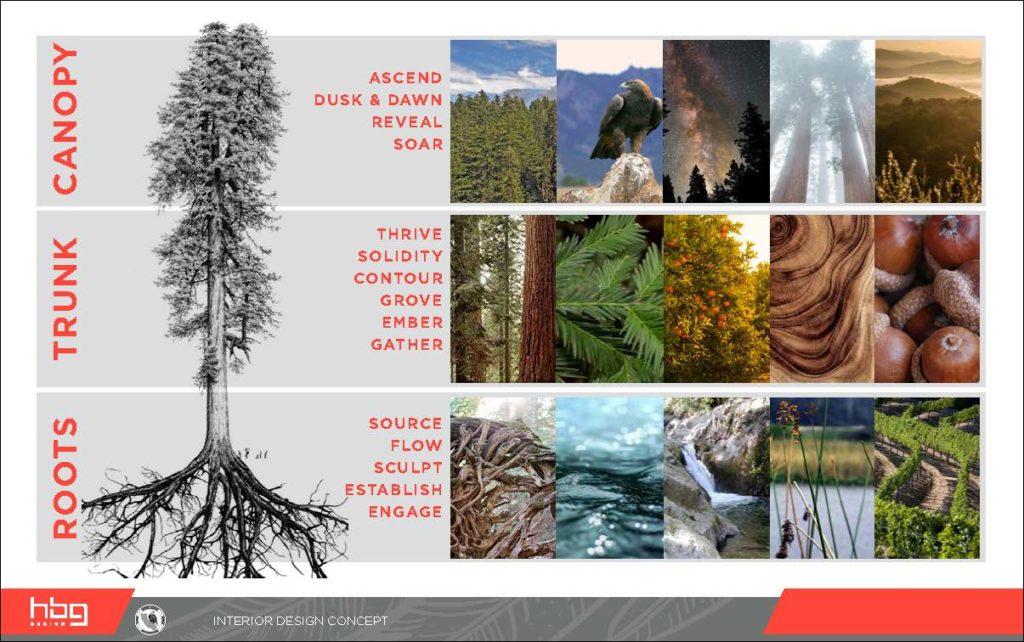 The Tribe met with HBG Design and shared elements of the rich tribal history, including archival images of beautiful baskets, the process of basket making along the Tule River, legends of tribal origin, and focused on the details of the higher elevations of the tribal homeland.
The Tribe met with HBG Design and shared elements of the rich tribal history, including archival images of beautiful baskets, the process of basket making along the Tule River, legends of tribal origin, and focused on the details of the higher elevations of the tribal homeland.
“As we started to get more and more involved and inspired by those Tribal themes, we began to wonder how we could integrate some of that history and some of that cultural richness of the giant sequoia tree, the mountainous region, the tales of the ‘hairy man’ as they call it, and the basket patterns themselves, which each hold very particular meaning. So as we started to learn about these things, it layered on to us a desire to create a property that spoke very closely to those themes,” said Rob Jurbergs, AIA, Principal, HBG Design.
HBG designed the new casino property with the vision of a lodge and a more mountainous style of architecture with a home in the Valley.
A DESIGN THAT SERVES COMMUNITY AND CULTURE
“For the Tule River Tribe, it was really important to tell their story. We researched their culture; they provided books to us, and photos of artifacts. They were really open about sharing their culture, which allowed us to find patterns within baskets to incorporate into our design that would give this property a uniqueness in the market when you look at some of the other competitive casinos, because it tells their story. It would also be very meaningful to the tribal members for us to incorporate basket patterns that, on the one hand, are cool casino elements and, on the other hand, recognizable to anyone with knowledge of the Tribal culture,” said Baruffaldi.
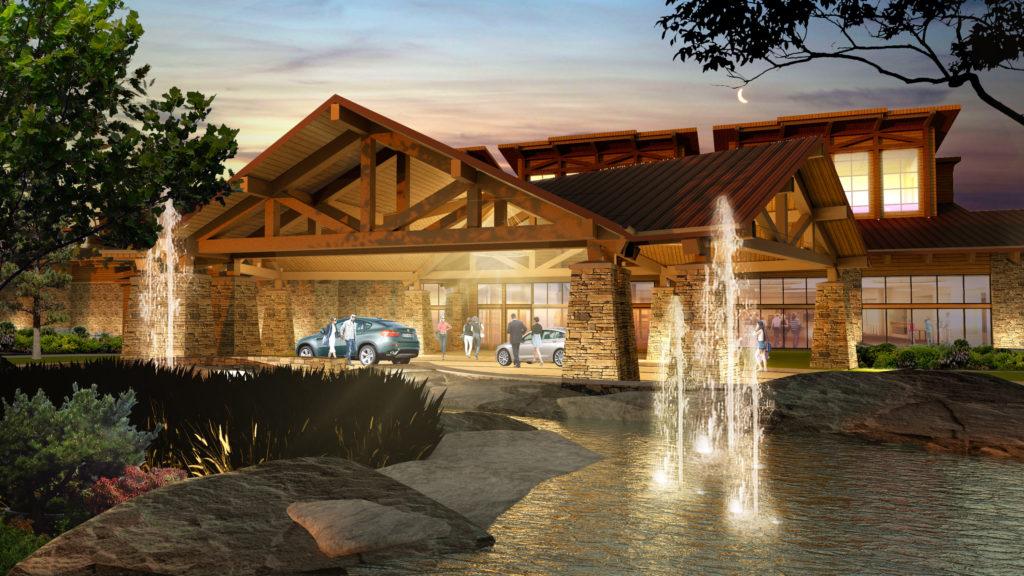 HBG Design was also trying to meet the market from a business perspective. One example of this is the inclusion of a Sports bar called ‘The Redwood Taphouse’ in the new casino property. The city of Porterville does not have a variety of options to view televised sporting events, and it is anticipated that this will be a hot spot for all sports lovers.
HBG Design was also trying to meet the market from a business perspective. One example of this is the inclusion of a Sports bar called ‘The Redwood Taphouse’ in the new casino property. The city of Porterville does not have a variety of options to view televised sporting events, and it is anticipated that this will be a hot spot for all sports lovers.
“Talking with Matthew Mingrone, the General Manager of Eagle Mountain Casino, he wanted to have a place in Porterville to go watch the game, so you start to have these business drivers that merge with these creative storytelling drivers to create an overall unique business driven property,” continued Baruffaldi.
DEVELOPMENT OF CONCEPTUAL THEMES
The Tule River Tribal Council as a whole were essential in helping HBG Design learn about tribal culture and embraced the idea of using the new relocation property as a platform for sharing their culture, while meeting the needs of the community. HBG Design created specific conceptual themes after speaking to tribal community groups and Tribal leadership to showcase and present some of the more significant meanings related to the Tribe.
“The design storytelling within the property as a whole involved the development of an overall concept that ties all of the different spaces together, as a platform to create an individual identity for each restaurant or venue within the property,” said Baruffaldi.
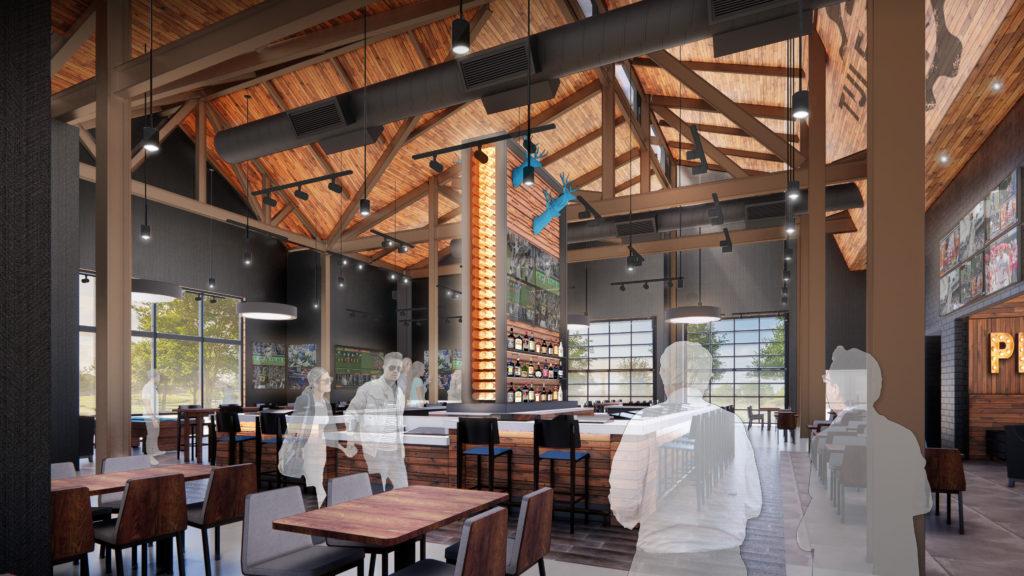 HBG Design took multiple aspects of the design inspiration depicting the story of the Tule River through the Tribe’s native traditions, art, patterns and imagery.
HBG Design took multiple aspects of the design inspiration depicting the story of the Tule River through the Tribe’s native traditions, art, patterns and imagery.
“During our early visioning workshops, we focused in on the words ‘Grounded’ and ‘Soaring’.
"Grounded” and “soaring” are more conceptual terms as it relates to the concept of the Giant Sequoia tree which is so large it can only be experienced truly by either the rooted connection to the earth, the trunk, and the soaring nature of the canopy because it is so tall and dwarfs everything else in the forest. With a better understanding of the tribe’s ancestral homeland and hearing the stories from tribal members related to both the Tribe’s past and the desire to create a project to represent a strong future to the Tule River tribe, we started to connect the theme from “Grounded” and “Soaring.” “Grounded” is about honoring the past, the heritage, the traditions, the elders, and all of the history of the tribal foundation. “Soaring” represents looking forward and creating opportunities for the Tribe with the new casino,” said Jurbergs.
 The giant sequoia concept was visualized in three parts: the roots, the trunk, and the canopy. Designers identified words and images that depict the nature and character of each part of the tree. An element that the Tule River Tribal Council started to understand and embrace was the storytelling behind the design and how HBG tied each of the giant sequoia aspects into different parts of the building.
The giant sequoia concept was visualized in three parts: the roots, the trunk, and the canopy. Designers identified words and images that depict the nature and character of each part of the tree. An element that the Tule River Tribal Council started to understand and embrace was the storytelling behind the design and how HBG tied each of the giant sequoia aspects into different parts of the building.
Additionally, the Tule River became a key design inspiration. The river is very dynamic, and as it travels from higher elevations, it creates majestic pools of water and waterfalls.
STRONG LODGE-STYLE ARCHITECTURAL EXPRESSION
Designers were influenced by a lodge aesthetic with wood and other stone structural expressions and wanted the design to be grounded in the land. Creating strong architectural elements of wood and stone became the forefront.
The porte-cochère will incorporate an eagle pattern design for the pendant lights, and the lodge-like lines and truss work with wood textures both in the main structural elements and in the ceiling itself, creating a lot of warmth and richness, making it very inviting for guests.
ENTRANCE AND CASINO FLOOR
As you drive up to the new relocation property and the porte-cochère, you will first notice water and a series of small pools reminiscent of the Tule River itself. It will be a part of the entry experience and will engage guests from the moment they arrive on the property. Water elements will wind in a serpentine fashion up to the front door and feature Native grasses and plant species native to the mountain that the Tribe felt necessary to incorporate into the property.
“Flowing forms recall the winding Tule River and organic curves of nature. When we were laying out the casino floor, we were thinking about how guests move through the project; we wanted to convey that flowing nature,” said Jurbergs.
There are so many incredible elements to be discovered as guests explore the new property. As you enter the property into the entry concourse, which ultimately will lead to a future hotel, it features a sculpture carving by a Tule River tribal member of a culturally significant figure, “the hairy man” or more commonly “big foot”.
Guests looking up at the ceiling will notice the unique geometry of a basket pattern with individual triangles that are super scaled to cover the whole casino ceiling. In addition, the use of four tribal basket patterns is featured on the concourse floor, and the light fixtures also feature basketry patterns. The column work is inspired by the giant sequoia trees’ bark and creates a contemporary element. The corridor will also showcase museum-like statements of actual works of art, bringing a rich historical feel to the entire property.
The countdown to Fall continues, and the excitement is building as the construction of the relocation nears completion. Soon the guests of The People’s Casino will be able to experience all of the fantastic designs and countless years of hard work put into this one-of-a-kind property.
Currently, Eagle Mountain Casino is located 17 miles east of Porterville and is a full-service casino owned and operated by the Tule River Tribe. Guests must be 18 years of age to enter. The casino is open 24/7. In addition, the Grizzly Food court is open 24/7, and the River Steakhouse is open Friday – Sunday from 5pm – 10pm. Eagle Mountain Casino is a short drive from Bakersfield or Visalia.
The new casino property is scheduled to open in late Fall of 2022, off Highway 65 in Porterville, CA, next to the Porterville Fair Grounds. The new property will double in size, growing to over 100,000 square feet, featuring new dining options, 1750 slot machines, 20 table games, and a 2000 seat state-of-the-art event center.
Creating Depth, Meaning and Authenticity in the Gaming Experience
"Casino design is its own special artform that has long since evolved from being simply a structural box with slot machines inside. At the best casinos and resorts, the casino designs are exciting and lively, but are also inspired by meaning and authenticity, with a beautiful flow from one amenity to the next.” - Christopher Wood, NCIDQ, IIDA, HBG Design
Christopher Wood, NCIDQ, IIDA, Lead Interior Designer and a casino design specialist contributes to this month's 'HBG Design Thinking'. Chris discusses how inspired, authentic and meaningful design can help differentiate and enhance the guest's gaming experience.
First, Chris, why are you passionate about casino and entertainment design?
Chris: As a casino design specialist here at HBG Design, I love creating spaces of refined elegance with a bit of glitz and glam. I love finding subtle ways to elevate a space. And it helps that I have a penchant for all things that sparkle. That tends to work well in casino design. The casino is the nucleus of the guest experience for a casino resort. Bringing in intricate detailing and refinement through materials that truly shine is something that always gets my creative juices going.
As a casino designer, where do you and your team find your design inspiration?
Chris: At HBG, we are fortunate to work with many distinctive tribal and commercial gaming clients with strong cultures, brands and regional ties, in some cases, to native ancestral lands. I love learning about our clients’ cultures. Being able to highlight stories of heritage respectfully, creatively, and typically within a more contemporary casino design framework, is challenging yet exciting.

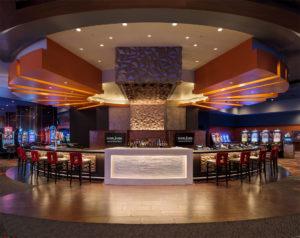
Shown above: the design of Ho-Chunk Gaming, Black River Falls, Wisconsin was directly influenced by the light and shadow filtering through the northern Wisconsin woods.
Nature is also a tremendous aspect of regional design inspiration. There is so much beauty in the world. Finding new ways to bring the outside world into our designed spaces is an unexpected surprise, especially in a casino. I like to reference underlying elements that we don't often think would be associated with a casino. For example, a sunrise, light and shadow, the night sky.
Each story can form the basis of a string of conceptual ideas that are personal and unique to each Owner. One-of-a-kind design really complements and elevates a gaming experience. We use ambience and emotional response to separate a property from the [casino] pack.
Can you give an example of a design inspired by culture or nature for regional customers?
Chris: Yes, the Tule River Tribe in California is currently developing their new 105,000 square foot Eagle Mountain Casino in Porterville, CA, which will enhance the tribe’s gaming and F&B amenities with a fresh interpretation of Tule River Tribal culture and heritage. Our design team merged cultural storytelling concepts with amenities and distinctive venues designed specifically for the Porterville gaming customer.
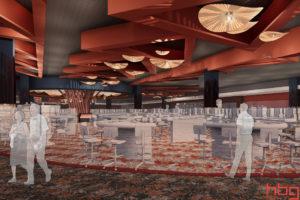 Key design concepts are rooted in the land and agrarian context of Tulare County and Central California with the design influenced heavily by a lodge aesthetic with wood and stone structural expressions. Inside, guests will experience an abstract depiction of the Tule River Tribe’s native traditions through art, patterns, and imagery. Soaring vertical features recall the majesty of the Giant Sequoia and the Golden Eagle, each important representations of tribal culture. Flowing forms will recall the winding Tule River and organic curves of nature.
Key design concepts are rooted in the land and agrarian context of Tulare County and Central California with the design influenced heavily by a lodge aesthetic with wood and stone structural expressions. Inside, guests will experience an abstract depiction of the Tule River Tribe’s native traditions through art, patterns, and imagery. Soaring vertical features recall the majesty of the Giant Sequoia and the Golden Eagle, each important representations of tribal culture. Flowing forms will recall the winding Tule River and organic curves of nature.
Custom terrazzo medallions of tribal basketry patterns will enhance the entrance concourse. Display cases will feature tribal artwork. The casino ceiling design features the Tule River Tribe's Flight of the Butterfly and Quail Tufts cultural pattern. Chandelier designs are inspired by native basketry. The carpeting is evocative of a shadowed forest floor. Wood accented columns help bring alive the idea of the towering sequoia.
Is there a particular aspect of the Eagle Mountain Casino project that you think will stand out to guests?
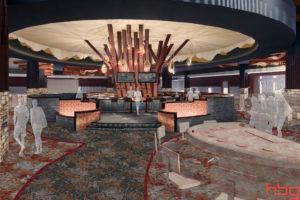 Chris: The Eagle Mountain Casino’s ceiling design and center bar is a design that I am particularly proud of for its eye-catching aesthetic. Guests will witness a culturally significant center bar design that harkens to the concept of fire as a community gathering place. We designed in elements reminiscent of glowing embers of a dwindling fire, and sourced custom floating ember-look light fixtures. A focal back bar element recalls stacked firewood. Warm crimsons and deep navy blues help express the color range that fire can have, leaving those gathered feeling warm and social.
Chris: The Eagle Mountain Casino’s ceiling design and center bar is a design that I am particularly proud of for its eye-catching aesthetic. Guests will witness a culturally significant center bar design that harkens to the concept of fire as a community gathering place. We designed in elements reminiscent of glowing embers of a dwindling fire, and sourced custom floating ember-look light fixtures. A focal back bar element recalls stacked firewood. Warm crimsons and deep navy blues help express the color range that fire can have, leaving those gathered feeling warm and social.
Are most Owners receptive to integrating cultural elements into the casino design?
Chris: Our team’s experiences working with Tribal design, especially, have been very diverse. We have created literal interpretations and incorporations of cultural identity into the entertainment experience. And have also designed more contemporary, abstracted nods to culture and heritage.
We design to each Owner’s specific vision; so no designs look alike. And, because many of the tribal casinos are often legacy investments supporting tribal communities, the casino design treatments can be incredible opportunities to create personality, emotion and memory within the context of a meaningful destination experience.

